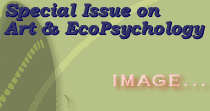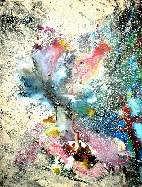

 |
 |
 |
 |
|
Introduction to the Section on Image:
|
Laura Sewell, in her excellent book, Sight and Sensibility: the EcoPsychology of Perception, points out that almost everything in our lives, not just the images we think of as constituting ‘art’, is filtered in some way through our visual sense. This, she continues, informs our every perception and even our capacity to imagine. As a metaphor, vision is boundless, and even in it’s purely physical form, the hegemony enjoyed by this one of our many senses is so pervasive that Mike Cohen, founder of the important ecopsychological school NatureConnect, has devised whole programs to break our dependence on this dominant sense. With
that level of significance in our lives, it is clear that sight
is a crucial element, and this Art & EcoPsychology section on
image contains an abundance of material designed to explore this
fascinating sense. I started my conceptualization of this issue in late 1999, when I interviewed the British-born, multi-talented environmental artist Christopher Castle. That first conversation with him, which to my great pleasure has not yet ceased generating ongoing interaction, was so fascinating that it turned out to be several hours long and extended itself into a second interview focusing on Castle’s musical projects (found in the Sound section of this issue). The interview is accompanied by many images of his fine work, ranging from the traditional icons whose form he has so beautifully revitalized, to stunning oils, charcoal and pastels. Feast your eyes. Environmental
artists of another sort have been gathering at a local land-fill
site in the California bay area for the last three years, and the
article on Art at the Bulb gives my impression of this exciting
urban art form. These artists utilize recycled materials and the
natural environment in their ever-changing open-air gallery, and
the article comes with a few selected images from the thousands
of digital photographs of the site taken by the eternally curious
and socially conscious digital artist Fletcher Oakes. There is a
brief selection of Fletcher’s own artwork - Digital Mandalas
- and a link to his website for more. ICE
member and practicing artist Lisa Lipsett contributes two wonderful
pieces, Painting Fear, and Not being Able to See. Not Being Able
to See is an internal dialogue, an ongoing commentary between her
seeing self and her fuzzy-visioned self, who not only have different
points of view, but hold completely different values. This charming
piece is illustrated with many of Lisa’s beautiful paintings.
Painting Fear is a visual prose poem that cleverly compares the
fear of painting with the fear of ‘wild’erness. The
Roots of the Ecological Self is a contribution of archetypal images
from new ICE member Jonathan Metcalfe. His work explores the field
of light and shadow, figuratively and metaphorically, and shows
an astonishing depth of vision. Archetypal images of another sort,
Native American sculptor Ned Bear honors us with the inclusion of
one of his magnificent masks. And finally, an on-line conversation with artist and mystic Michel Durant—on visual perception, science, light, and mysticism—led to this piece on Unified Field theory. The article attempts to describe some of the physical and metaphysical phenomena that inspired the Pointillists, and other artists who worked with light, around the turn of the century. This is a viewpoint that could make you look at those old paintings, and everything else for that matter, with new eyes.
|
